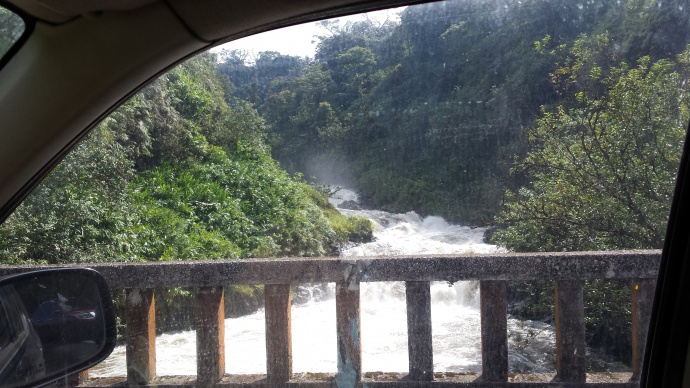Wet Season Rainfall Outlook for State of Hawaiʻi

This image shows just how full some of the streams were from the recent rains. They were taken at around 4 p.m. on Tuesday, Aug. 25, 2015, near Mile 20 of the Hāna Highway. Image credit: Jackie Frost. Aug. 26, 2015.
The National Oceanic and Atmospheric Administration released its 2016 Wet Season Rainfall Outlook for the State of Hawaiʻi today.
The report states that probabilities favor near to above average rainfall through spring of 2017, with above average rainfall also reflected in the climate model consensus predictions.
There’s also indications that drought recovery is probable for remaining areas on Kauaʻi and Maui. During the dry season, which ran from May through September 2016, most of the state was drought-free except for small sections of leeward Maui near Kīhei, and leeward Kauaʻi near Hanapēpē.
The agency’s Climate Prediction Center issued a “La Niña Watch” on Oct. 13, 2016, saying the current El Niño-Southern Oscillation-neutral conditions are transitioning to a La Niña state (cool phase).
The Outlook, which covers the period from October 2016 to April 2017 notes that while La Niña is favored to develop during the fall, it may not be long-lived and is only slightly favored (55% chance) to persist through the winter.
According to NOAA, prior wet seasons during weak La Niña events have had near average rainfall in the Hawaiian Islands; which prior wet seasons during El Niño-Southern Oscillation-neutral events tend to have above average rainfall in the Hawaiian Islands.
During the dry season, most locations across the state had near to above average rainfall, with drought mainly affecting ranching operations.
NOAA reports that Hawaiʻi is coming off of the second wettest dry season in the last 30 years, based on rankings from eight key sites. The 2015 dry season was the wettest in the last 30 years.
Monthly rainfall records in the 2016 dry season broke records at several locations in July, August, and September. According to NOAA, above average tropical cyclone activity near Hawaiʻi and above average sea surface temperatures have helped increase rainfall.
Tropical cyclones and other tropical weather features brought associated rain bands over the islands and enhanced moisture from the deep tropics to fuel intense rainfall, according to today’s update.
Tropical Storm Darby made landfall on the Big Island in July and its trailing rain band produced damaging flash floods on Oʻahu. Enhanced moisture from a weak tropical disturbance also contributed to severe flash flooding in the Wailuku River on Maui in September, leading to a federal disaster declaration.
Wet season preparedness reminders
- Do not drive on roads with fast-flowing water: Just 2 feet of fast-flowing water can sweep most vehicles off a road. Roads may also be severely undercut.
- Do not walk across flooded streams: If you’re hiking and get stranded, wait for the water to recede. Streams in Hawaiʻi generally recede quickly.
- Expect more rainy weather impacts: This can result in increased road travel times; possible detours or road closures due to flooding or landslides; and outdoor activities may be postponed, canceled, or adjusted.
- The wet season brings increased potential for lightning strikes: Be prepared for power outages and move indoors during a thunderstorm.
- If you travel through a flood-prone area, identify alternate routes ahead of time.
- If you live in a flood-prone area, have an evacuation plan in case flood waters quickly threaten your home.
- Stay informed of conditions that could change rapidly: Sunny skies can turn cloudy with intense rainfall in less than an hour. Check out the latest forecasts, watches, warnings, and advisories via the media, NOAA Weather Radio, the Internet, or one of several weather mobile phone apps.
- Wireless Emergency Alerts on mobile phones notify you that you’re in a flash flood warning area.










